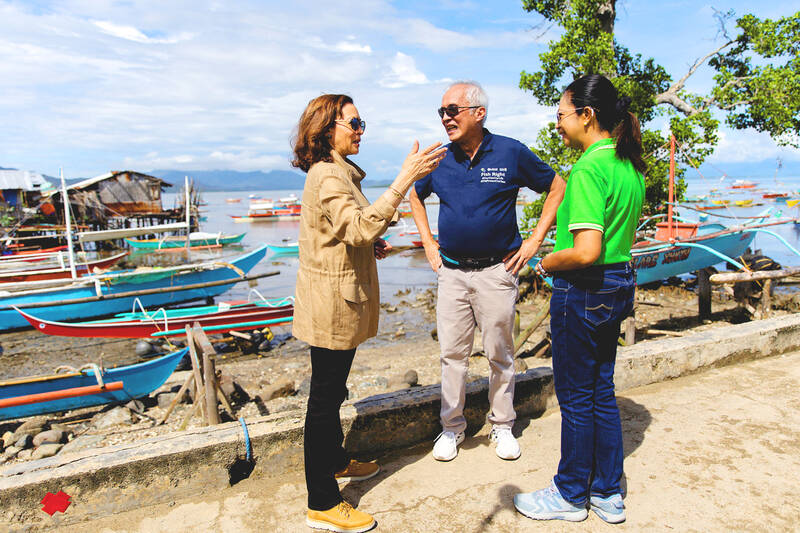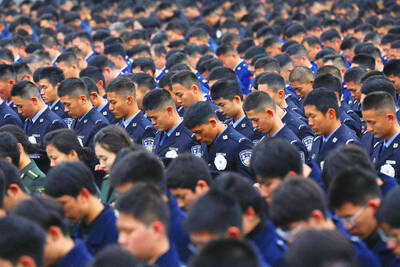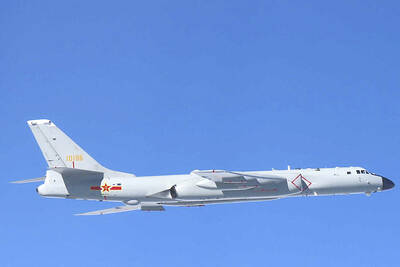US Vice President Kamala Harris yesterday visited a Philippine island near waters claimed by Taiwan and China to show support for the longtime US ally and counter Beijing’s growing influence in the region.
Harris is the highest-ranking US official ever to visit the western island of Palawan, the closest Philippine landmass to the Spratly Islands (Nansha Islands, 南沙群島) in the hotly contested South China Sea.
Beijing claims sovereignty over almost the entire sea and has ignored an international court ruling that its claims have no legal basis. Taiwan, the Philippines, Brunei, Malaysia and Vietnam have overlapping claims to parts of it.

Photo: Reuters
Harris met with fishers in a coastal village and members of the Philippine Coast Guard.
In a speech, she said that “international rules and norms” must be upheld and the UN-backed tribunal decision rejecting China’s claims over the South China Sea respected.
“The United States — and the broader international community — have a profound stake in the future of this region,” Harris said, on board a Philippine Coast Guard vessel.
“As an ally, the United States stands with the Philippines in the face of intimidation and coercion in the South China Sea,” she said.
Harris’s trip to Palawan comes a day after she held talks with Philippine President Ferdinand Marcos in Manila.
She reaffirmed the US’ “unwavering” commitment to defending the Philippines if its vessels or aircraft were attacked in the South China Sea.
Washington has a decades-old security alliance with the Philippines that includes a mutual defense treaty and a 2014 pact, known as the Enhanced Defense Cooperation Agreement (EDCA), which allows for the US military to store defense equipment and supplies on five Philippine bases.
It also allows US troops to rotate through those military bases.
Harris’s visit conveyed a “stronger sense of commitment” to the Philippines’ position on maritime claims, but also underscored the need for the EDCA’s continued implementation, said Jay Batongbacal, director of the University of the Philippines’ Institute for Maritime Affairs and Law of the Sea.
“The US cannot adequately carry out its obligations if it is forced to stay several thousand kilometers away in Japan or Guam,” he said.
Of all the claimants to the South China Sea, Beijing has in the past few years pressed its stance the most aggressively. Hundreds of Chinese coast guard and maritime militia vessels prowl the waters, swarming reefs, harassing and attacking fishing and other boats, and interfering in oil and gas exploration, as well as scientific research.
China’s Global Times yesterday accused Harris of “fanning the flames of the South China Sea issue” in an editorial.
“The Philippines has the right to receive any foreign visitor. What we want to emphasize is that any bilateral exchanges should not be at the expense of the interests of any third country as well as regional peace and stability,” it said.

PARLIAMENT CHAOS: Police forcibly removed Brazilian Deputy Glauber Braga after he called the legislation part of a ‘coup offensive’ and occupied the speaker’s chair Brazil’s lower house of Congress early yesterday approved a bill that could slash former Brazilian president Jair Bolsonaro’s prison sentence for plotting a coup, after efforts by a lawmaker to disrupt the proceedings sparked chaos in parliament. Bolsonaro has been serving a 27-year term since last month after his conviction for a scheme to stop Brazilian President Luiz Inacio Lula da Silva from taking office after the 2022 election. Lawmakers had been discussing a bill that would significantly reduce sentences for several crimes, including attempting a coup d’etat — opening up the prospect that Bolsonaro, 70, could have his sentence cut to

China yesterday held a low-key memorial ceremony for the 1937 Nanjing Massacre, with Chinese President Xi Jinping (習近平) not attending, despite a diplomatic crisis between Beijing and Tokyo over Taiwan. Beijing has raged at Tokyo since Japanese Prime Minister Sanae Takaichi last month said that a hypothetical Chinese attack on Taiwan could trigger a military response from Japan. China and Japan have long sparred over their painful history. China consistently reminds its people of the 1937 Nanjing Massacre, in which it says Japanese troops killed 300,000 people in what was then its capital. A post-World War II Allied tribunal put the death toll

A passerby could hear the cacophony from miles away in the Argentine capital, the unmistakable sound of 2,397 dogs barking — and breaking the unofficial world record for the largest-ever gathering of golden retrievers. Excitement pulsed through Bosques de Palermo, a sprawling park in Buenos Aires, as golden retriever-owners from all over Argentina transformed the park’s grassy expanse into a sea of bright yellow fur. Dog owners of all ages, their clothes covered in dog hair and stained with slobber, plopped down on picnic blankets with their beloved goldens to take in the surreal sight of so many other, exceptionally similar-looking ones.

‘UNWAVERING ALLIANCE’: The US Department of State said that China’s actions during military drills with Russia were not conducive to regional peace and stability The US on Tuesday criticized China over alleged radar deployments against Japanese military aircraft during a training exercise last week, while Tokyo and Seoul yesterday scrambled jets after Chinese and Russian military aircraft conducted joint patrols near the two countries. The incidents came after Japanese Prime Minister Sanae Takaichi triggered a dispute with Beijing last month with her remarks on how Tokyo might react to a hypothetical Chinese attack on Taiwan. “China’s actions are not conducive to regional peace and stability,” a US Department of State spokesperson said late on Tuesday, referring to the radar incident. “The US-Japan alliance is stronger and more